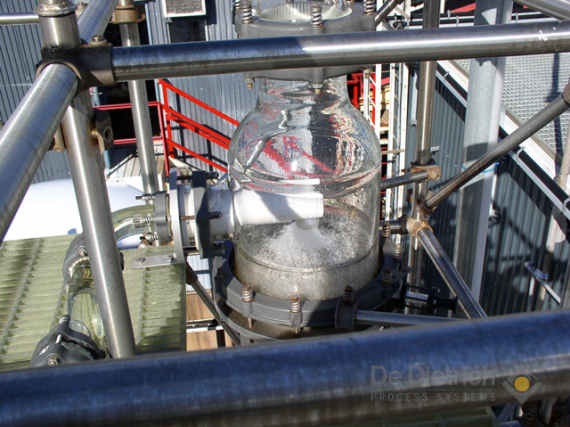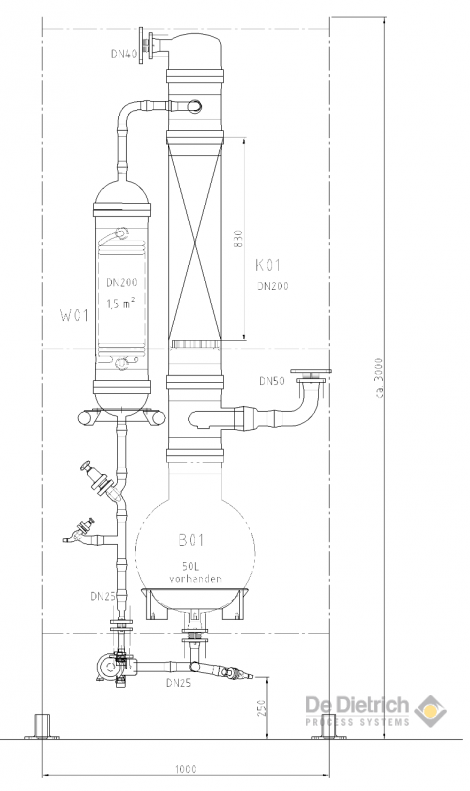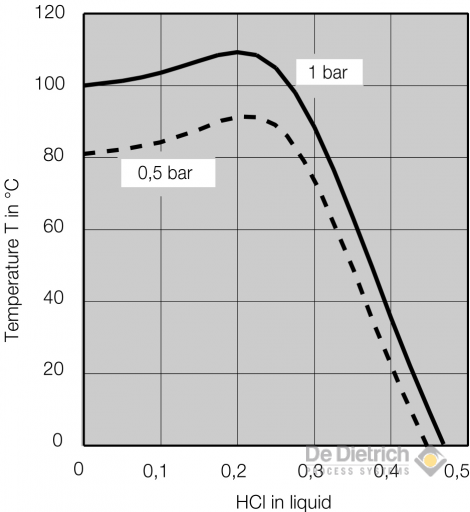Absorption of HCl


General
Hydrogen chloride is produced as a by-product or waste gas by a variety of processes within the process industries. In many countries there are strict maximum emission levels for hydrogen chloride which mean that it must be removed from waste gas streams. This may be done simply by scrubbing it out of the waste gas, or where the quantities are large enough, by absorbing it to produce a hydrochloric acid product.
Hydrogen chloride has a great affinity for water and the absorption can be easily accomplished as long as a suitable method is found to contact the gas and the water. The absorption of hydrogen chloride into water causes a great deal of heat to be evolved which has to be removed from the system. The theoretical maximum concentration achievable is dependent on the temperature and the partial pressure of HCI in the exhaust gas entering the plant.
The most appropriate HCI absorption process for any particular application depends on the nature of the feedstock and on the product required. The three basic types are batch wise operated HCI scrubbers or continuously operated adiabatic and isothermal absorbers.
Hydrogen chloride and hydrochloric acid are very corrosive materials and will attack many materials of construction commonly used in the chemical process industries. Borosilicate glass is the ideal material of construction, being suitable for handling hydrogen chloride gas, hydrochloric acid, and any impurities present with the exception of hydrofluoric acid.
HCl Scrubber with and without neutralisation
The HCl gas scrubber represents the simplest form of an HCI absorber operating continuously with respect to the gas flow and batch wise with respect to the absorbing liquid. It finds particular application where the concentration of the hydrogen chloride is low and further processing to form hydrochloric acid has no economic advantage. The aim is to remove the HCl from waste gas streams. In this type of unit the liquid to gas ratio in the column is usually very high. Any heat of solution generated in the process will therefore be taken up by the liquid phase, thus avoiding the need for coolers. Increased concentration or increased total amount of HCl in the gas stream may require to remove the generated heat which is done by a cooler placed in the recirculation loop. The addition of sodium hydroxide to the absorption liquid neutralizes absorbed HCl and hence improves mass transfer leading to a more efficient scrubbing process. To achieve this a vessel to hold the neutralising absorption liquid is situated together with a pump at the base of the column. This liquid is circulated through the column, absorbing continuously HCl gas until the absorbing liquid becomes semi-batch wise neutralized. This can be monitored by continuous pH measurement.
HCl-Scrubber DN200

Absorption of HCl in water
The absorption of hydrogen chloride in water is strongly exothermic ~2100 kJ/kg HCl, which means that the absorption liquid becomes easily warm. High concentrations of HCl in water can be achieved only at temperatures lower than 40°C.In order to keep these low temperatures the removal of absorption energy is necessary. This removal is done in different ways, as further described as isothermal and adiabatic HCl-absorption.
Boiling point of hydrochloric acid as function of the HCl-concentration


